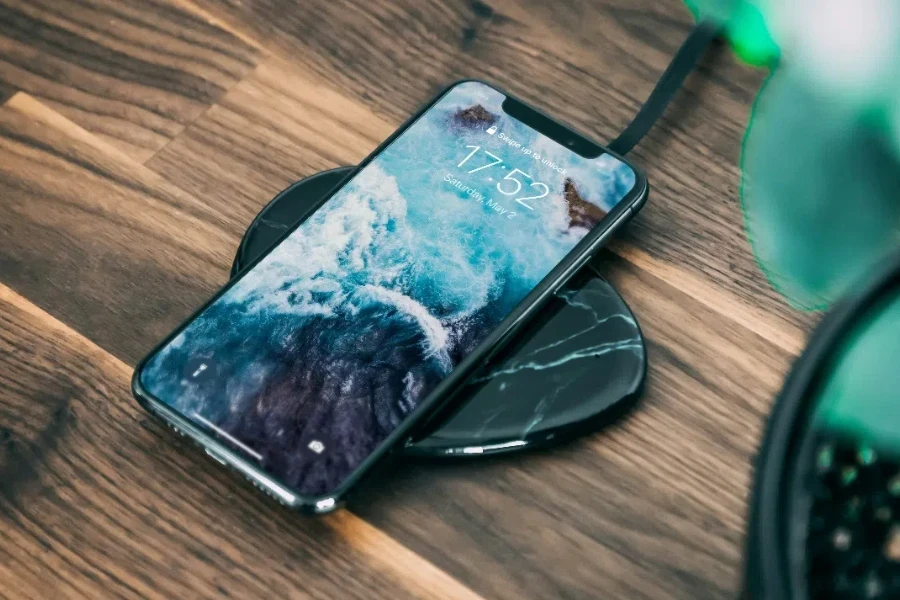The wireless phone chargers market is experiencing rapid growth, driven by technological advancements and increased adoption in various industries. In 2025 and beyond, professional buyers must navigate a range of options to find the best solutions. This article provides an in-depth analysis of market trends, consumer preferences, and key technical specifications to help businesses make informed purchasing decisions.
Table of Contents:
Understanding Wireless Charging Market Trends
Consumer Preferences in Wireless Phone Chargers
Technical Specifications to Consider
Evaluating Build Quality and Durability
Additional Features and Innovations
Understanding Wireless Charging Market Trends

Market Growth Projections
The wireless phone chargers market is poised for significant growth in the coming years. According to Research and Markets, the market is forecasted to grow by USD 12.58 billion during 2023-2028, accelerating at a CAGR of 23.85% during the forecast period. This growth is driven by the increasing adoption of smartphones with built-in wireless charging capabilities and the need for a common charging platform. The global market for wireless phone chargers was valued at USD 3.1 billion in 2023 and is projected to reach USD 3.6 billion by 2030, growing at a CAGR of 2.4% from 2023 to 2030.
The market’s expansion is further supported by the proliferation of electric vehicles (EVs) and the integration of wireless charging pads in automobiles. The wireless chargers market, which includes phone chargers, is expected to grow by USD 68.42 billion during 2023-2028, with a CAGR of 23.5%. This growth is attributed to the increasing adoption of the Qi standard, the rise in global smartphone shipments, and the growth of embedded wireless chargers in various applications.
Key Market Drivers
Several key drivers are propelling the growth of the wireless phone chargers market. The increasing adoption of smartphones and other devices with built-in wireless charging capabilities is a major driver. As more smartphone manufacturers incorporate wireless charging into their devices, the demand for compatible chargers continues to rise. Additionally, the convenience and aesthetic appeal of wireless charging, which eliminates the need for cables and reduces clutter, are significant factors driving market growth.
Technological advancements in wireless charging are also playing a crucial role. Innovations such as fast wireless charging technology and multi-coil charging pads are improving the efficiency and convenience of wireless charging. The integration of wireless charging capabilities into a wider range of consumer electronics, including tablets, smartwatches, and earbuds, is expanding the market. Furthermore, the adoption of the Qi wireless charging standard by most major smartphone manufacturers is driving compatibility across different devices, making wireless charging more accessible to a broader audience.
Regional Market Insights
The wireless phone chargers market exhibits significant regional variations in terms of growth and adoption. North America, particularly the United States and Canada, represents a substantial portion of the global market share for wireless charging devices. The region’s strong consumer demand for convenient and efficient power solutions is driving market growth. Additionally, North America is home to key players in the industry, contributing to advancements in resonant and radio frequency-based technologies for wireless power transfer.
Asia-Pacific is another significant region in the wireless charging market, both in terms of production capacity and adoption rates. Countries like China, Japan, and South Korea have invested heavily in infrastructure that supports EVs with integrated wireless charging systems. The competitive landscape in Asia highlights numerous regional players fostering innovation and cost-effective solutions. The European market has also shown steady growth, driven by strong research institutions and the integration of wireless charging systems into vehicles by European automakers.
Consumer Preferences in Wireless Phone Chargers

Popular Charging Technologies
Consumer preferences in wireless phone chargers are heavily influenced by the available charging technologies. Inductive charging, which uses electromagnetic fields to transfer energy between two objects, is one of the most popular technologies. This method is widely adopted due to its reliability and efficiency. According to Research and Markets, the inductive technology segment is expected to reach USD 1.8 billion by 2030, growing at a CAGR of 2.8%. Magnetic resonance technology, which allows for greater flexibility in device placement, is also gaining traction, with a projected CAGR of 2.3% over the same period.
Another emerging technology is radio frequency (RF) charging, which enables wireless power transfer over longer distances. This technology is still in its early stages but holds significant potential for the future. The integration of RF charging into various consumer electronics could revolutionize the market by offering more versatile and convenient charging solutions. As these technologies continue to evolve, consumer preferences are likely to shift towards more efficient and flexible wireless charging options.
Design and Aesthetics
Design and aesthetics play a crucial role in consumer preferences for wireless phone chargers. Consumers are increasingly looking for chargers that not only function well but also complement their home or office decor. Sleek and minimalist designs are particularly popular, as they blend seamlessly into modern living spaces. Manufacturers are responding to this demand by offering a wide range of stylish and aesthetically pleasing wireless chargers.
In addition to design, the portability and convenience of wireless chargers are important factors for consumers. Compact and lightweight chargers that can be easily carried around are highly sought after. The integration of wireless charging pads into furniture and public spaces, such as airports and cafes, further enhances the convenience factor. As consumers continue to prioritize design and convenience, manufacturers are likely to focus on developing innovative and visually appealing wireless charging solutions.
Brand Perception
Brand perception significantly influences consumer preferences in the wireless phone chargers market. Established brands with a reputation for quality and reliability tend to attract more consumers. Companies like Apple, Samsung, and Belkin are well-regarded in the market and have a loyal customer base. These brands are known for their high-quality products and innovative technologies, which instill confidence in consumers.
On the other hand, emerging brands are also making their mark by offering competitive pricing and unique features. As the market becomes more saturated, brand differentiation through innovation and customer service will become increasingly important. Consumers are likely to gravitate towards brands that offer not only reliable products but also excellent after-sales support and warranty services. As brand perception continues to shape consumer preferences, companies will need to focus on building strong brand identities and maintaining high standards of quality and customer satisfaction.
Technical Specifications to Consider

Charging Speed and Efficiency
Charging speed and efficiency are critical factors when evaluating wireless chargers. The latest models, such as the Anker PowerWave Pad, support up to 10W fast wireless charging for compatible devices, ensuring a quick and stable power supply. For iPhones, it provides a constant 7.5W charge, making it highly compatible with several smartphone models.
Efficiency is also a key consideration, as it impacts the overall energy consumption and heat generation during charging. Advanced chargers incorporate features like temperature control and overvoltage protection to maintain optimal efficiency. For instance, the Belkin Boost Up Wireless Charging Stand includes these safety features, ensuring efficient and safe charging.
Compatibility with Devices
Compatibility with various devices is essential for a versatile wireless charger. Most modern chargers, such as the Samsung Wireless Charger Duo, support Qi-enabled devices, including smartphones, smartwatches, and earbuds. This charger can simultaneously charge a smartphone and another device, like a smartwatch or earbuds, making it highly convenient for users with multiple gadgets.
Additionally, some chargers are designed with specific ecosystems in mind. The Mophie 3-in-1 Wireless Charging Pad, for example, is tailored for Apple devices, offering dedicated charging spots for an iPhone, Apple Watch, and AirPods. This ensures that users can charge all their devices efficiently without compatibility issues.
Safety Certifications
Safety certifications are crucial to ensure that wireless chargers meet industry standards and provide safe charging experiences. Certifications like Qi certification from the Wireless Power Consortium (WPC) indicate that a charger has passed rigorous testing for safety and performance. For example, the Anker PowerWave Pad is Qi-certified, ensuring it meets high safety standards.
Other important safety features include foreign object detection, temperature control, and overvoltage protection. These features prevent potential hazards such as overheating and short-circuiting. The Choetech Wireless Charging Stand, for instance, includes these safety measures, providing users with peace of mind during charging.
Evaluating Build Quality and Durability

Material and Finish
The material and finish of a wireless charger significantly impact its durability and aesthetic appeal. High-quality materials like aluminum and premium plastics are commonly used to enhance durability. For instance, the Satechi Dock5 Multi-Device Charging Station features a rugged aluminum build, ensuring long-lasting performance.
The finish also plays a role in the overall user experience. A non-slip surface, like the one found on the Anker PowerWave Pad, helps keep devices securely in place during charging. Additionally, a sleek and modern design can complement various environments, from home offices to bedside tables.
Resistance to Wear and Tear
Resistance to wear and tear is another important factor when evaluating the durability of wireless chargers. Chargers that are frequently used or transported need to withstand daily wear and tear. The Belkin Boost Up Wireless Charging Stand, with its robust and stable design, is built to endure regular use without compromising performance.
Moreover, features like water and dust resistance can further enhance a charger’s durability. While not all wireless chargers offer these features, those designed for outdoor or travel use, such as the Ugreen Nexode 20,000mAh Power Bank, often include them to ensure reliable performance in various conditions.
Additional Features and Innovations

Multi-Device Charging Capability
Multi-device charging capability is a highly sought-after feature in wireless chargers. Chargers like the Samsung Wireless Charger Duo and the Mophie 3-in-1 Wireless Charging Pad allow users to charge multiple devices simultaneously. This feature is particularly useful for households or individuals with several gadgets, as it reduces the need for multiple chargers and cables.
These chargers often include multiple charging pads or dedicated spots for different devices, ensuring efficient and organized charging. For example, the Samsung Wireless Charger Duo has two charging pads, allowing users to charge a smartphone and a smartwatch or earbuds at the same time.
Smart Features and Connectivity
Smart features and connectivity options are becoming increasingly common in wireless chargers. Some chargers now include Bluetooth or Wi-Fi connectivity, enabling users to monitor and control charging through a mobile app. For instance, the Anker 637 Magnetic Desktop Charging Station offers smart features that allow users to manage charging settings and monitor power usage.
Additionally, features like LED indicators provide real-time feedback on the charging status, ensuring that devices are properly aligned and charging efficiently. The Belkin MagSafe 3-in-1 Wireless Charging Stand includes an LED indicator to inform users when their devices are correctly positioned and charging.
Portability and Convenience
Portability and convenience are essential for users who need to charge their devices on the go. Compact and lightweight designs, such as the Anker PowerWave Magnetic 2-in-1 Stand, make it easy to carry chargers in bags or pockets. This charger is ideal for travelers or professionals who need a reliable charging solution while away from home.
Moreover, features like foldable designs and built-in cable management enhance portability and convenience. The Ugreen Nexode 20,000mAh Power Bank, for example, offers a high-capacity portable charging solution with multiple ports, making it perfect for users who require power on the go.
Wrapping Up
In conclusion, when selecting a wireless charger, it’s essential to consider factors such as charging speed, compatibility, safety certifications, build quality, and additional features. By evaluating these aspects, business buyers can ensure they choose reliable and efficient charging solutions that meet their needs.




